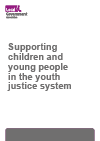
Introduction
Councils are responsible for the safety and well-being of all young people in their areas. When it comes to youth justice, that responsibility means working with young people to prevent them from coming into the youth justice system in the first place, and supporting those who do to make sure it doesn’t define them, and they still have good life chances.
There are many varying and complex reasons young people may end up involved in crime. In the majority of cases, those reasons are issues that local authorities working with partners, can help young people tackle. As the cohort in conflict with the law has contracted, the children now involved with the system have more complex and overlapping education, health and social care needs. Their offending behaviours often mask underlying vulnerabilities: from early childhood trauma and neglect to school exclusion, poor mental health and growing up in poverty. The severity and types of offences committed by children have shifted; average custodial sentences are longer; and, levels of violence between children, with staff and self-harm in custody are all high and rising. Exploring different ways that work to keep children safe and stop offending behaviours is essential.
These case studies explore those different ways some councils are supporting children and young people in the youth justice system.
